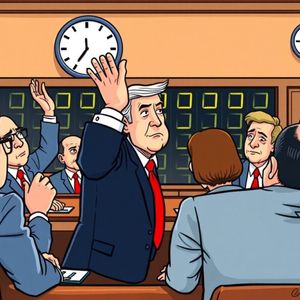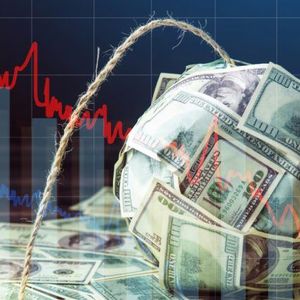Fed Interest Rates: The Surprising Divergence Shaping Future Policy
7 min read
BitcoinWorld Fed Interest Rates: The Surprising Divergence Shaping Future Policy The cryptocurrency market often dances to the tune of macroeconomic shifts, and few instruments wield as much influence as the U.S. Federal Reserve’s decisions on Fed interest rates . Recently, the crypto world watched closely as the Fed concluded its latest FOMC meeting, revealing not just a steady hand on rates but also a surprising internal division that could ripple through global finance and digital asset valuations. Understanding these nuances is crucial for anyone navigating the volatile waters of the digital economy. What Did the Fed Decide on Fed Interest Rates? At its most recent Federal Open Market Committee (FOMC) meeting, the U.S. Federal Reserve opted to keep its benchmark Fed interest rates unchanged. This decision was largely anticipated by market participants, signaling a continued cautious approach to monetary policy. However, the accompanying statement provided little concrete guidance on the future trajectory of rates, leaving investors to ponder when, or if, rate cuts might occur. The Fed’s assessment of the economy, as outlined in its statement, highlighted several key points: Unemployment remains low: A strong labor market continues to be a cornerstone of the U.S. economy. Labor market is robust: Indicating healthy employment figures and wage growth. Inflation is rising moderately: Suggesting that while price pressures are present, they are not spiraling out of control. Economic growth slowed somewhat: The first half of the year saw a deceleration in economic activity. Despite these observations, the statement conveyed a sense of ongoing uncertainty about the future economic landscape. This blend of stability in the present and ambiguity for the future is precisely what makes the internal dynamics of the Fed so critical to observe. Why Are Fed Officials Divided on Fed Interest Rates? Perhaps the most striking revelation from the FOMC meeting was the visible crack in the committee’s consensus regarding Fed interest rates . For the first time in 30 years, two board members, Christopher Waller and Michelle Bowman, both appointed by President Trump, publicly opposed the decision to keep rates frozen. Their dissent stemmed from a belief that the current monetary policy was “too restrictive.” This rare display of disagreement is significant for several reasons: Historical Precedent: A two-member dissent on a rate freeze is highly unusual, underscoring deep-seated differences in economic philosophy within the Fed’s highest ranks. Policy Debate: Waller and Bowman’s argument suggests they believe the economy is being unduly constrained by current high rates, potentially advocating for a more accommodative stance sooner rather than later. This contrasts with the majority view, which likely prioritizes continued vigilance against inflation. Future Implications: Such internal friction could signal potential shifts in future policy directions. If more members begin to lean towards the “too restrictive” view, it could accelerate the timeline for rate cuts, or at least soften the Fed’s hawkish tone. Understanding this divergence is crucial because it indicates that the path forward for Fed interest rates is not a unanimous one, and future decisions may involve more internal debate than previously assumed. What’s Next for Fed Interest Rates: Navigating Economic Uncertainty? The Fed’s statement offered a conditional outlook on future policy adjustments. It suggested that if the trend of slowed economic growth continues, the central bank “may consider cutting Fed interest rates in the future.” This conditional language highlights the data-dependent nature of the Fed’s approach. They are not committing to cuts but are acknowledging the possibility if economic conditions warrant it. Key factors the Fed will be closely monitoring include: Inflation Trends: Will inflation continue to moderate, or will it reignite? This remains a primary concern. Labor Market Health: While currently strong, any significant weakening in employment figures could prompt a policy shift. Global Economic Developments: External factors, such as geopolitical events or slowdowns in major economies, can also influence the Fed’s decisions. The “uncertainty about the future economy remains high” according to the Fed, reinforcing the idea that flexibility and adaptability will be paramount in their upcoming policy deliberations. For investors, this means remaining agile and responsive to incoming economic data and Fed communications. How Do Fed Interest Rates Impact Your Crypto Portfolio? The relationship between Fed interest rates and the cryptocurrency market is multifaceted and often inverse. When interest rates are high or rising, the cost of borrowing increases, and traditional, lower-risk investments like bonds become more attractive. This can draw capital away from riskier assets, including cryptocurrencies, leading to downward pressure on their prices. Conversely, when interest rates are expected to fall or are low, the opposite often occurs: Increased Liquidity: Lower rates can lead to more money flowing into the economy, some of which finds its way into speculative assets like crypto. Reduced Opportunity Cost: The appeal of traditional investments diminishes, making high-growth potential assets like Bitcoin and Ethereum more attractive relative to bonds or savings accounts. Investor Sentiment: A more accommodative monetary policy signals a willingness by the Fed to support economic growth, which can boost overall investor confidence and risk appetite. Therefore, while the Fed’s decision to hold rates steady might seem neutral, the internal dissent and the hints of future cuts, if economic slowdowns persist, could be interpreted by the crypto market as a potentially bullish signal down the line. Traders and long-term holders alike keep a keen eye on these macroeconomic indicators for clues about future market movements. Preparing for the Future: Actionable Insights on Fed Interest Rates Given the current economic landscape and the Fed’s cautious stance on Fed interest rates , how can investors, particularly those in the crypto space, position themselves? Here are some actionable insights: Stay Informed: Regularly monitor official Fed statements, press conferences, and economic data releases. These are primary sources of information that can provide clues about future policy. Diversify Your Portfolio: While tempting to go all-in on high-growth assets, a diversified portfolio can help mitigate risks associated with sudden market shifts influenced by monetary policy. Understand Risk Tolerance: Assess your personal risk tolerance. If the Fed adopts a more hawkish stance, risk assets like crypto might face headwinds. Be prepared for volatility. Consider Long-Term Strategies: For many crypto investors, a long-term “HODL” strategy can help weather short-term market fluctuations driven by macroeconomic news. Focus on the underlying technology and adoption rather than day-to-day price swings. Look for Innovation: Even in uncertain times, projects with strong fundamentals, real-world utility, and innovative technology tend to perform better in the long run. The Fed’s path is not set in stone, and adaptability will be key. By understanding the forces at play and making informed decisions, you can better navigate the evolving economic climate. Conclusion: The latest FOMC meeting delivered a mixed bag for market watchers: stability in the present but significant internal debate and lingering uncertainty about the future of Fed interest rates . The rare dissent from Waller and Bowman underscores a growing divergence of opinion within the central bank, hinting at potential shifts in monetary policy down the road. For the cryptocurrency market, these developments are not mere background noise; they are critical indicators that can influence liquidity, investor sentiment, and ultimately, asset valuations. As the Fed continues to balance inflation control with economic growth, staying attuned to their signals will be paramount for making strategic investment decisions in the dynamic world of digital assets. Frequently Asked Questions (FAQs) 1. What was the key outcome of the recent FOMC meeting regarding Fed interest rates? The U.S. Federal Reserve kept its benchmark Fed interest rates unchanged at the latest FOMC meeting. However, the statement did not specify when future rate cuts might occur, maintaining a data-dependent stance. 2. Who opposed the Fed’s decision, and why was this significant? Christopher Waller and Michelle Bowman, two board members appointed by President Trump, opposed the rate freeze. This was significant because it was the first time in 30 years that two board members publicly dissented on a rate freeze, arguing that the current monetary policy was “too restrictive.” 3. How does the Fed currently view the U.S. economy? The Fed views unemployment as low, the labor market as strong, and inflation as rising moderately. However, it noted that economic growth slowed somewhat in the first half of the year and that uncertainty about the future economy remains high. 4. What is the potential impact of Fed interest rates on the cryptocurrency market? Generally, higher Fed interest rates can make traditional investments more attractive, potentially drawing capital away from riskier assets like cryptocurrencies. Conversely, lower rates can increase liquidity and make crypto more appealing, often leading to upward price pressure. 5. When might the Fed consider cutting interest rates? The Fed indicated it “may consider cutting interest rates in the future” if the trend of slowed economic growth continues. Their decision will be highly dependent on incoming economic data, including inflation and labor market figures. 6. What does “monetary policy too restrictive” mean in this context? When monetary policy is considered “too restrictive,” it implies that the current high interest rates are hindering economic growth more than necessary. Dissenting members believe that these high rates are overly constraining business investment, hiring, and consumer spending, and should be lowered sooner. If you found this analysis insightful, consider sharing it with your network on social media. Your insights contribute to a more informed community navigating the complexities of the financial world and the future of digital assets! To learn more about the latest crypto market trends, explore our article on key developments shaping Bitcoin and Ethereum price action. This post Fed Interest Rates: The Surprising Divergence Shaping Future Policy first appeared on BitcoinWorld and is written by Editorial Team

Source: Bitcoin World



